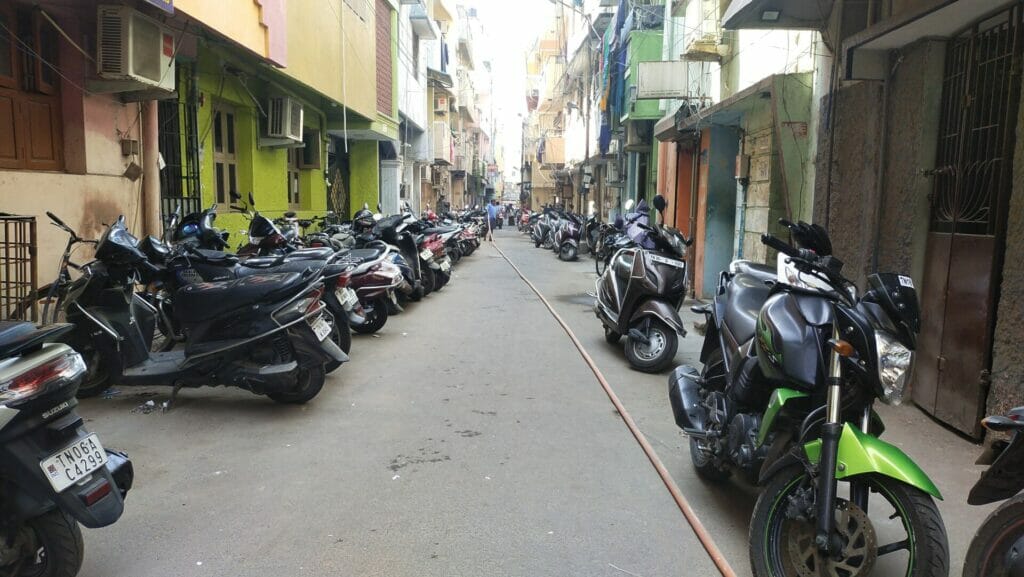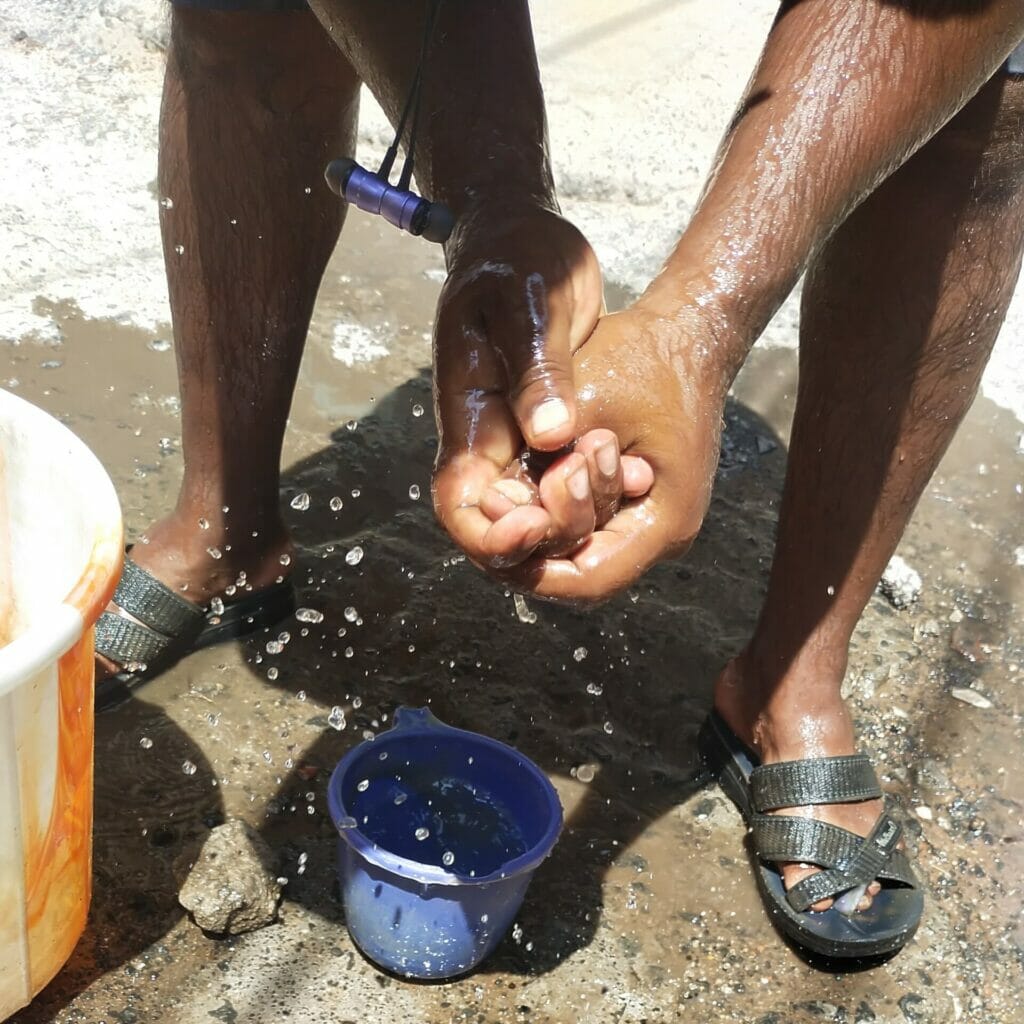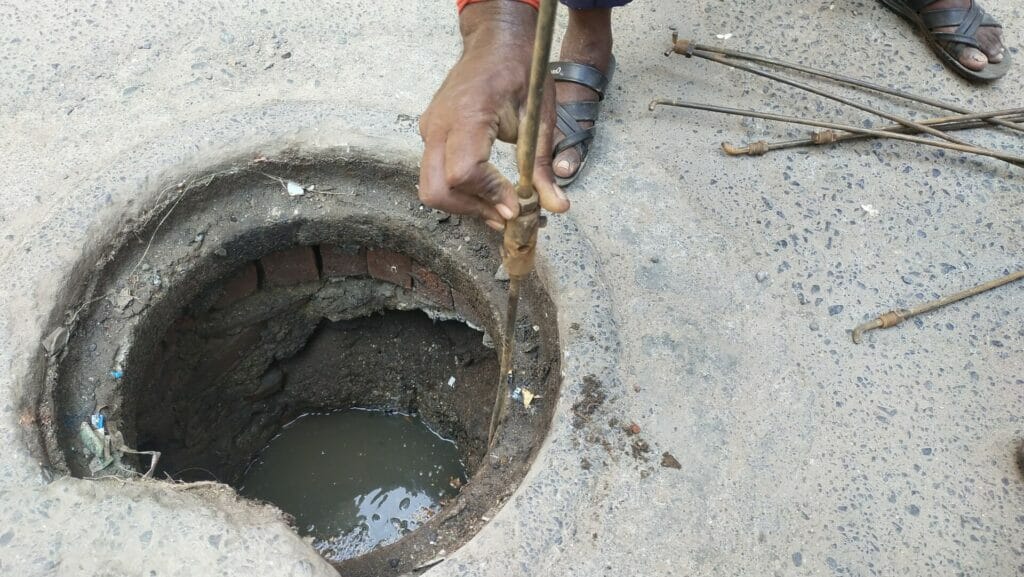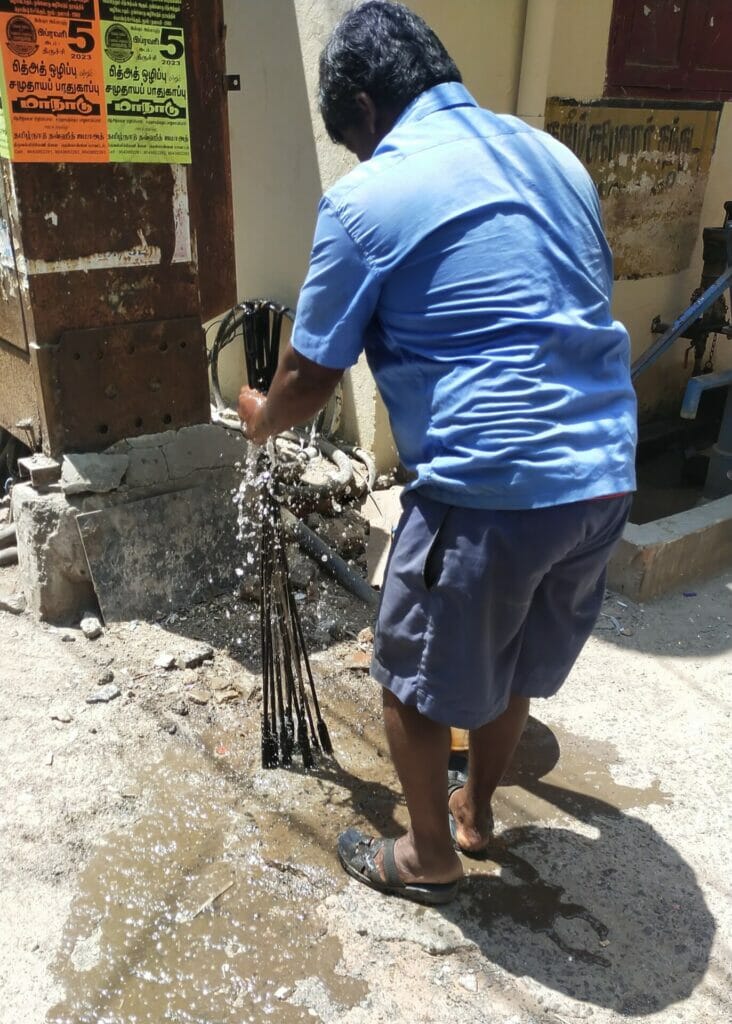Around 20 years ago, Kannan*, was a 20-year-old youngster taking up odd jobs to support his family in Chennai’s Tambaram. He had dropped out of school. It was around this time that he came to know of an ongoing recruitment drive for a government job. The essential qualification for this job was to have a good lung capacity to be able to hold one’s breath underwater. When Kannan showed up for the test, he found that the challenge was not in being able to hold his breath but rather, it was the water he was dealing with. He had been asked to get into a manhole of the underground sewage system as part of the recruitment process. Those who were able to hold their breath for more than a minute were selected for the job. The government job that Kannan took the test for was called ‘Moozhkalai’, meaning manual workers in Chennai who get into the manholes. The nodal agency that hired the workers was the Chennai Metropolitan Water Supply and Sewerage Board (CMWSSB).
“I held my breath for more than 100 seconds and so I was recruited,” says Kannan, who is 40 now.
Over the past two decades, Kannan has had to enter many manholes in Chennai. He has had to witness many of his colleagues lose their life on the job due to its inherently unsafe nature.
If one were to wonder why someone would choose to continue working such a job, Kannan’s answer is that there is no other choice.
We shadowed Kannan for a day to understand what the job looks like for many of the city’s manual workers engaged by the CMWSSB.
The Prohibition of Employment as Manual Scavengers and their Rehabilitation Act, 2013 make the hazardous cleaning of sewers by workers entering into manholes illegal. According to the law, the process must completely be mechanised.
Read more: Chennai’s garment workers forever exploited, as watchdog looks the other way
A regular morning for a manual worker in Chennai
Kannan starts his day as early as 6 am, commuting from his home in Tambaram, located over 30 km away from Chennai’s core city area. He takes the local train to the Park Station and then a bus to reach his zonal office. By around 8.30 am he reports to the CMWSSB officials in the zonal office. He is then supplied with a paper which has his work orders allocated for the day.

On this day, he requires the jet-rodding machine to attend to the first two complaints.
Along with the driver of the jet-rodding machine and another permanent manual worker (also called a field worker), Kannan reaches the street adjacent to the complaint spot at around 9.30 am.

“The jet rodding machine which is mounted on a lorry was under repair for the past three days. We got it back from the mechanic only today,” says Kannan as he moves the two-wheelers parked on either side of a narrow street through which the lorry has to pass to reach the spot.
“Most of the time the two-wheeler owners will not be available nearby to move the vehicle. We will have to carry it elsewhere as the vehicles will be side-locked,” he adds as he moves a bike that weighs at least a 100 kg. Many such parked vehicles have to be moved before the lorry can advance.
Kannan then checks the street and directs the driver to the spot. After about 25 minutes and many obstacles, the lorry reaches the other end of the narrow street. He then knocks at the door of the complainant and verifies the complaint.
The individual’s complaint was about the blockage in his underground drainage connection.
A bright orange hose from the jet rodding machine is then unrolled and stretched towards the complainant’s house. While Kannan inserts the hose into the septic tank, the driver releases water from the jet rodding machine. They communicate through phone calls to stop and start the water as and when required.

A few minutes later, Kannan takes a long rod and opens the main manhole chamber on the street near the complainant’s house. With the help of the permanent worker, he inserts the hose into the manhole and checks for any blockage.
As the blockage in the house continues to exist, both the manual workers open another manhole on the opposite side of the house and repeat the same process of flushing it with water.

After over 40 minutes the blockage is finally cleared. Kannan then gets a signature from the complainant on the work allocation document.
The workers then roll back the hose, which is now tainted with sewage from underground. Using a waste cloth, Kannan wipes the hose while placing it back into the jet-rodding machine.
The lorry proceeds to move to attend to the next complaint.
Ill-treatment of manual workers in Chennai

The second complaint is about the overflowing main chamber located at a junction of four roads.
Using a long iron rod Kannan opens the cement slab of the manhole. As the cement slab is broken, he removes the broken pieces using his hands. Meanwhile, the lorry driver parks the lorry at the street corner and unrolls the hose.
As the work holds up traffic, commuters angrily yell at the manual workers as they pass by.
“Do you have no other place to park the lorry?” asks a motorist.

Kannan and the other workers continue to work not paying heed to the comments.
As they insert the hose into the manhole, the water from the chamber starts to overflow onto the street. They then drag the hose to another manhole which is some 50 meters away from the lorry and check for blockages there.

After around 30, the sewage overflowing from the chamber starts to ebb.
“The block is now cleared,” says Kannan. As he closes the manholes with the broken cement slabs, he says, “These slabs were put in only six months ago. It is broken already.”

While the manual workers roll back the hose to place it in the lorry, a commuter on a two-wheeler drives his bike on the hose and slips. The workers run to his rescue only to be faced with more anger from the public.
“This usually happens. When I joined work 20 years ago, there were around 20 manual workers for 37 streets in Chennai. At least 17 of them were permanent workers. Now, we have four workers for 48 streets of which only one person is permanent. With mounting workload, we can pay attention only to a few things. We cannot take up the work of traffic diversions or guarding the commuters,” says Kannan.
“We are often misunderstood for causing public inconvenience while we are trying to ease the public’s inconvenience,” says Kannan.
Read more: Frontline workers in Chennai battle the rains with poor support and scarce empathy
Safety gear alien to manual workers in Chennai

Kannan and the other workers are offered a glass of juice by the owner of a nearby juice shop as the finish working under the harsh sun.
Kannan then sends the jet-rodding machine back to the depot and takes his cycle to the next complaint spot. The permanent manual worker accompanies Kannan.
“Since the street is very narrow, jet-rodding machine or silt auto cannot be brought inside to clean the blocks,” says Kannan.
In such cases, workers use iron rods to manually remove the blockage.
“Each rod is one metre long,” says as he proceeds to unpack them from the cycle and connects them one after another using small nuts and bolts.
The connected rods are then inserted into the manhole. “We need at least 13 such rods to clear the blocks in these narrow streets,” says Kannan.
After over 40 minutes of unclogging, the blockage in the chamber begins to clear up.
“We will have to wait until the water flows seamlessly,” says Kannan.
He then starts to disconnect the rods and requests a nearby resident to provide him with a piece of waste cloth and a bucket of water. He wipes the rods while pulling them out from the chamber and then washes it with water and packs them.
When quizzed about safety or protective equipment used by manual workers, Kannan says, “It is of no use to us. Once in a while, the government gives us a pair of gloves, a yellow helmet, reflective coats and boots. If I wear gloves, I cannot tighten the nuts and bolts in the rods. If I wear the boots in this scorching sun, I will end up with heat burns on my legs. I will have to spend at least Rs 500 to get medicated for the burns. It has been more than three years since the government provided uniforms for the temporary workers so usable safety gear is out of the question,” he says.

Even as lunchtime nears, there is no sign of Kannan taking a break.
When asked about it, he says, “How will we have the appetite to eat after continuously working on the manholes? On most days I skip my lunch and manage with tea.”
While office hours end by 5 pm, manual workers in Chennai cannot go home until the complaints are attended to.
“If there is an overflowing chamber, we cannot go home leaving it as such. There have been times during the floods when I stayed back for three days at work,” he says.
Can machines take the place of manual workers in Chennai?
Kannan is of the strong opinion that in a country like India, it would be impossible to do away with manual scavenging. He says, “Even when we have lorries or robots, the structures we work with are still age-old. It is still called ‘manholes’ which means it is meant for humans to get inside and clean.”

“For instance, when a big stone is stuck in a 10-feet deep manhole, the block cannot be cleared even if we use super-sucker machines or jet-rodding machines. In such cases, we have to dig the road at regular intervals to spot the block. It takes a high level of time and manual work. We have to keep digging one portion of the road, then close it and repeat the same until we spot the block. This is not only a waste of money but also causes public inconvenience. The public anger is reflected only on us,” he says.
Kannan is of the view that unless the entire sewage infrastructure in Chennai is revamped, manual scavenging will continue in one form or another.
Speaking about the news of new machines purchased by governments to eradicate manual scavenging, Kannan says, “A three-in-one machine costing Rs 40 lakhs was recently purchased by the government. The machine has the facilities of inserting the rods, jet-rodding and silt removal mounted in one vehicle. However, this vehicle has a meagre water storage capacity unlike the lorries being used at present. Half the time will be wasted in refilling the water. Besides, it requires at least four people to operate.”
Kannan hopes for better pay for manual workers before the experimental purchase of machines not suited for the kind of work that is needed to be carried out in the city.
No benefits for the hard work of manual workers in Chennai
When Kannan joined work in 2004, his salary was Rs 90 per day.
“Despite our protests, the government switched us from temporary workers to contract workers in 2005. We were paid Rs 100 per day by the contractor. Though the government promised to make our jobs permanent and remove contractors from the picture. This is yet to take place. We only see the contractors changing once in a few years,” says Kannan.
Every time a contractor changes, workers get a hike of Rs 10 per day.
“Between 2017 and 2019, the CMWSSB made payments to the workers directly. This gave us some hope. We were paid the minimum wages as per the collector’s order. However, the CMWSSB contractualised our work again in March 2022. I earn a sum of Rs 613 per day (Rs 18,390 per month) at present. But this figure is only on paper. I receive only a sum of Rs 11,000 or Rs 12,000 per month,” says Kannan.

The temporary workers of CMWSSB staged a ten-day protest against contractualisation of their labour in May 2022. Kannan says that since then the attendance has not been marked for them. As a result, the manual workers of Chennai cannot claim their rightful salary.
“Even if we work for 30 days, we get paid only for 26 days. I have been told that a certain amount from my salary is debited under the Employees’ State Insurance (ESI) Scheme. In the past 20 years, I have not even seen my ESI card. Even if I die tomorrow, my family is likely to receive no benefits from my two decades of labour,” says Kannan.
After resolving his last complaint for the day, Kannan heads back to the depot at 5 pm. This was a rare good day on the job.
“When I was hired, I felt that the government (CMWSSB) was recruiting us directly, someday they will make us permanent workers so our children will get some benefits even after we die. I have harboured this hope for 20 years. Yet, nothing much has changed,” says Kannan.
Kannan carries on his daily commute of 60 km a day and continues to engage in hard manual labour under dangerous conditions despite all odds, waiting for this unkept promise from two decades ago to be fulfilled. All that workers like Kannan have left is hope.
Sometimes, it is this hope that kills.
*name changed on request.



its a shame that we are not able to improve conditions of these workers..manual scavenging has actualy been banned, how does govt still issue ‘orders’ for thse?